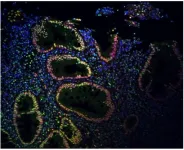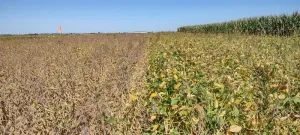(Press-News.org) -With images and videos-
Researchers from Durham University have uncovered new insights into social contagion in chimpanzees, revealing that these primates are capable of catching friendly behaviours, which may strengthen social bonds and increase group harmony.
The study, conducted at the Chimfunshi Wildlife Orphanage in Zambia, observed two affiliative behaviours—grooming and play—and found that these behaviours can spread among group members in a way that promotes group cohesion.
This groundbreaking study has been published in the journal PLOS ONE, which expands our understanding of social contagion, often thought to relate mostly to negative or neutral behaviours, by showing how positive social actions can also ripple through a community.
Chimpanzees, much like humans, exhibit social and emotional awareness, and their behaviours can be influenced by observing others.
In the study, individuals were more likely to begin grooming or playing after watching another chimp engage in the same activity. Importantly, grooming contagion tended to occur more frequently between close social partners, a pattern found with other empathic behaviours.
Play contagion, on the other hand, was especially pronounced in younger chimpanzees, who often rely on play as a primary form of socialisation.
The findings suggest that behavioural contagion may be an important mechanism underlying group dynamics in social animals, helping to maintain harmony and cooperative relationships.
Lead author of the study, Georgia Sandars of Durham University said: “Researching basic social processes in chimpanzees allows us to better understand healthy social functioning in our ape relatives, and gives insights into the evolution of human sociality.”
Researchers note that these processes in chimpanzees could provide a model for understanding the evolutionary roots of human social behaviour and empathy.
By highlighting the role of positive emotional contagion in a non-human primate species, the study invites further exploration into how similar processes operate across animal species, potentially shaping group living and social stability.
The study was conducted in a naturalistic, non-invasive manner, strictly adhering to ethical guidelines, and it involved over 200 hours of observation of 41 chimpanzees.
This research underscores the adaptability of primates in social interaction and offers significant contributions to fields studying animal behaviour, empathy, and social bonding.
ENDS
Media Information
Georgia Sandars and Prof Zanna Clay from Durham University are available for interview and can be contacted on georgia.sandars@durham.ac.uk and zanna.e.clay@durham.ac.uk.
Alternatively, please contact Durham University Communications Office for interview requests on communications.team@durham.ac.uk or +44 (0)191 334 8623.
Source
‘ChimpanSEE, ChimpanDO: Grooming and play contagion in chimpanzees’, (2024), G. Sandars, J. Brooker & Z. Clay, PLOS ONE.
An embargoed copy of the paper is available from Durham University Communications Office. Please email communications.team@durham.ac.uk.
Graphics
Associated images are available via the following link: https://www.dropbox.com/scl/fo/n563g7w8k8cbt1arxl95v/AP2G46a1_Vhuu41OyhwgtK4?rlkey=hdexdoxfcl1wpfrs1sro0sqoe&st=jbjlt82g&dl=0
Photo credit: Dr Jake Brooker
Video credit: Georgia Sandars
About Durham University
Durham University is a globally outstanding centre of teaching and research based in historic Durham City in the UK.
We are a collegiate university committed to inspiring our people to do outstanding things at Durham and in the world.
We conduct research that improves lives globally and we are ranked as a world top 100 university with an international reputation in research and education (QS World University Rankings 2025).
We are a member of the Russell Group of leading research-intensive UK universities and we are consistently ranked as a top 10 university in national league tables (Times and Sunday Times Good University Guide, Guardian University Guide and The Complete University Guide).
For more information about Durham University visit: www.durham.ac.uk/about/
END OF MEDIA RELEASE – issued by Durham University Communications Office.
END
New Durham University study shows friendly social behaviors are contagious for chimpanzees
Embargoed until 19.00 GMT on Wednesday 20 November 2024
2024-11-20
ELSE PRESS RELEASES FROM THIS DATE:
Megapixel fluorescence microscopy through scattering layers made simple
2024-11-20
A team from The Hebrew University of Jerusalem has introduced a new method for megapixel-scale fluorescence microscopy through complex scattering media. This approach resolves high-resolution images from several tens of widefield fluorescence-microscope frames without requiring specialized equipment such as spatial-light modulators or intensive computational processing. By efficiently correcting distortions caused by light scattering, the technique allows for clear imaging of dense and challenging targets. Its compatibility with conventional microscopy setups, coupled with the use of established matrix-based techniques, makes it practical for widespread use.
A recent ...
Over 4 million US adults with chronic liver disease can be grouped into unique risk groups based on barriers to care
2024-11-20
People with chronic liver disease can be categorized into four distinct risk groups based on the different barriers they face in obtaining outpatient care, barriers that increase their odds of requiring hospitalization, a new UCLA study finds.
The findings, to be published November 20 in the peer-reviewed PLOS ONE, point to the need for interventions aimed at reducing possibly avoidable hospitalizations among the highest-risk people with chronic liver disease (CLD). Previous research has found that people with CLD on average need more hospital-based care than those with other chronic diseases.
About ...
Robot flies like a bird
2024-11-20
Have you ever wondered why an airplane has a vertical tailfin? The plane needs it to stabilize its flight. Since flying without a vertical tail is much more energy-efficient, the aviation industry has worked hard to accomplish this – so far without much success. However, birds don’t need a vertical fin, which raises the question: how do they do it?
David Lentink, Professor of Biomimetics at the University of Groningen, has developed a robotic bird model with real pigeon feathers to show how they do it. In previous work, he found that birds continuously ...
Won’t you be mine? Neighborly networking may motivate local climate action
2024-11-20
Individual motivation to act against climate change outweighs the impact of hyperlocal collective intentions, though both approaches are worth strengthening, according to a survey of nine European neighborhoods published Nov. 20, 2024 in the open-access journal PLOS Climate by Christian A. Klöckner from the Norwegian University of Science and Technology and colleagues.
Western society contests the individual versus collective responsibility to combat climate change. But do people feel more motivated to act individually (e.g., making waste-free purchasing choices) or in tandem with others (e.g., protesting or completing ...
Mental health issues are "prevalent and troubling" among forcibly displaced children and young people, per scoping review which finds PTSD, anxiety and depression to be most common conditions
2024-11-20
Mental health issues are "prevalent and troubling" among forcibly displaced children and young people, per scoping review which finds PTSD, anxiety and depression to be most common conditions.
+++++
Article URL: https://journals.plos.org/mentalhealth/article?id=10.1371/journal.pmen.0000076
Article Title: Mental health issues of children and young people displaced by conflict: A scoping review
Author Countries: Nigeria, United States
Funding: The authors received no specific funding for this work. END ...
How nerve stimulation could ease inflammatory bowel disease
2024-11-20
Researchers at Duke University School of Medicine have found that tapping into the nervous system could help reduce the gut inflammation that drives inflammatory bowel disease (IBD).
A new study led by Luis Ulloa, PhD, and Wei Yang, PhD, reveals how electrical stimulation of the vagus nerve—a major nerve connecting the brain and gut—may combat the stress-related inflammation that worsens IBD symptoms.
Published in Science Translational Medicine, the study showed that vagus nerve stimulation in stressed mice with colitis, a form of IBD, reduced inflammation, improved symptoms, ...
The factors behind the shifting trends of ischemic heart disease and stroke
2024-11-20
Incidence of stroke and ischemic heart disease are declining around the world, except for in a handful of regions, according to research in the open access journal PLOS Global Public Health. Wanghong Xu of Fudan University and colleagues find that in East and West Sub-Saharan Africa, East and Central Asia and Oceania, ischemic heart disease is increasing, which may be attributed to eight factors that include diet, high BMI, household air pollution and more.
Cardiovascular disease is a leading cause of death and disability worldwide, and ischemic heart disease and stroke ...
How educational attainment may impact memory and dementia risk later in life
2024-11-20
Historical policies shaping educational attainment have enduring benefits for later life memory and risk of dementia, according to a study led by a Rutgers Health researcher.
The study, published in Epidemiology, compared the differences in years of education based on variations in state schooling mandates with cognitive performance outcomes in residents decades later.
“Policies to increase the quantity or quality of schooling now are likely to have long-term benefits on cognitive outcomes,” ...
Growing soybeans has a surprisingly significant emissions footprint, but it’s ripe for reduction
2024-11-20
AMES, Iowa – Over the typical two-year rotation of corn and soybeans most Iowa farmers use, 40% of nitrous oxide emissions are in the soybean year, according to a new study by an Iowa State University research team.
The share of the potent greenhouse gas released during the soybean half of a crop rotation cycle is surprisingly high, given most soybeans fields aren’t treated with nitrogen, said Michael Castellano, agronomy professor and William T. Frankenberger Professor of Soil Science at Iowa State University.
“We’ve just been assuming that legume crops like soybeans don’t have a big emissions footprint because they don’t ...
$6 million grant drives potential treatment for common cause of vision loss toward the clinic
2024-11-20
The California Institute for Regenerative Medicine (CIRM), the state’s stem cell agency, has awarded a two-year, $6 million grant to a team at the USC Dr. Allen and Charlotte Ginsburg Institute for Biomedical Therapeutics and the USC Roski Eye Institute advancing a new treatment for one of the leading causes of blindness in older adults. The funding will enable the researchers to conduct preclinical studies needed before launching human trials.
The investigators aim to accelerate progress in fighting dry age-related macular degeneration (AMD), which affects ...
LAST 30 PRESS RELEASES:
New expert guidance urges caution before surgery for patients with treatment-resistant constipation
Solar hydrogen can now be produced efficiently without the scarce metal platinum
Sleeping in on weekends may help boost teens’ mental health
Study: Teens use cellphones for an hour a day at school
After more than two years of war, Palestinian children are hungry, denied education and “like the living dead”
The untold story of life with Prader-Willi syndrome - according to the siblings who live it
How the parasite that ‘gave up sex’ found more hosts – and why its victory won’t last
When is it time to jump? The boiling frog problem of AI use in physics education
Twitter data reveals partisan divide in understanding why pollen season's getting worse
AI is quick but risky for updating old software
Revolutionizing biosecurity: new multi-omics framework to transform invasive species management
From ancient herb to modern medicine: new review unveils the multi-targeted healing potential of Borago officinalis
Building a global scientific community: Biological Diversity Journal announces dual recruitment of Editorial Board and Youth Editorial Board members
Microbes that break down antibiotics help protect ecosystems under drug pollution
Smart biochar that remembers pollutants offers a new way to clean water and recycle biomass
Rice genes matter more than domestication in shaping plant microbiomes
Ticking time bomb: Some farmers report as many as 70 tick encounters over a 6-month period
Turning garden and crop waste into plastics
Scientists discover ‘platypus galaxies’ in the early universe
Seeing thyroid cancer in a new light: when AI meets label-free imaging in the operating room
Neutrophil-to-lymphocyte ratio may aid risk stratification in depressive disorder
2026 Seismological Society of America Annual Meeting
AI-powered ECG analysis offers promising path for early detection of chronic obstructive pulmonary disease, says Mount Sinai researchers
GIMM uncovers flaws in lab-grown heart cells and paves the way for improved treatments
Cracking the evolutionary code of sleep
Medications could help the aging brain cope with surgery, memory impairment
Back pain linked to worse sleep years later in men over 65, according to study
CDC urges ‘shared decision-making’ on some childhood vaccines; many unclear about what that means
New research finds that an ‘equal treatment’ approach to economic opportunity advertising can backfire
Researchers create shape-shifting, self-navigating microparticles
[Press-News.org] New Durham University study shows friendly social behaviors are contagious for chimpanzeesEmbargoed until 19.00 GMT on Wednesday 20 November 2024



